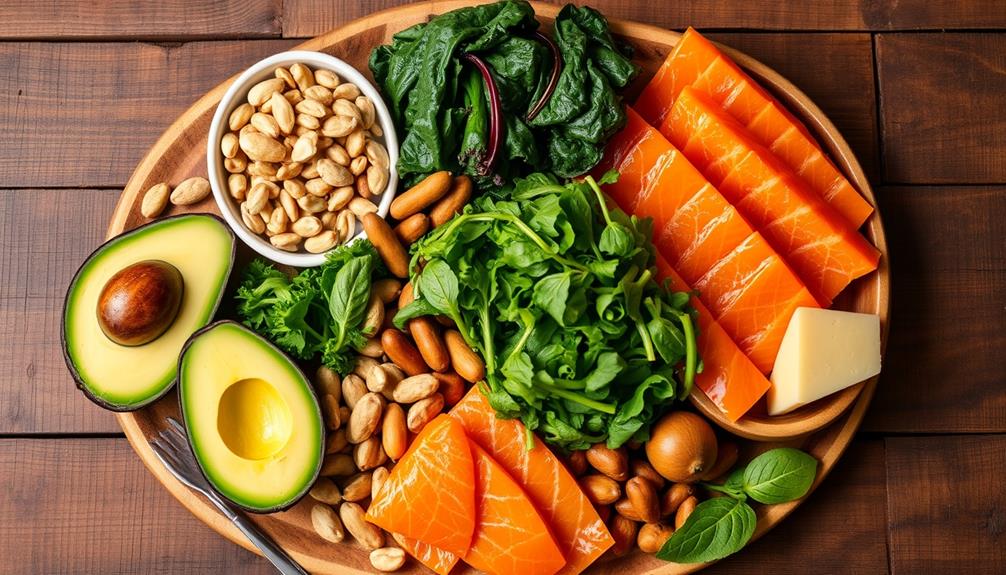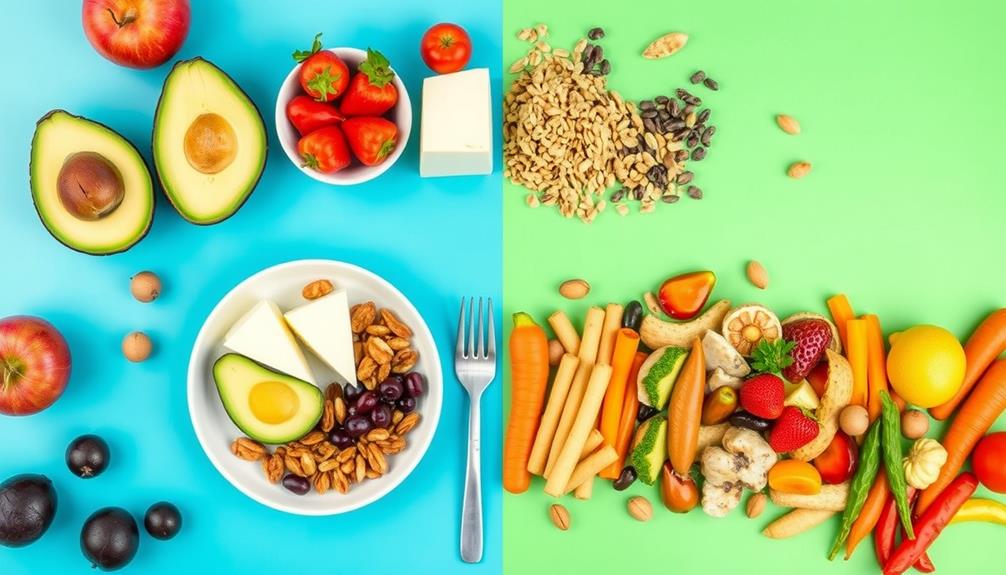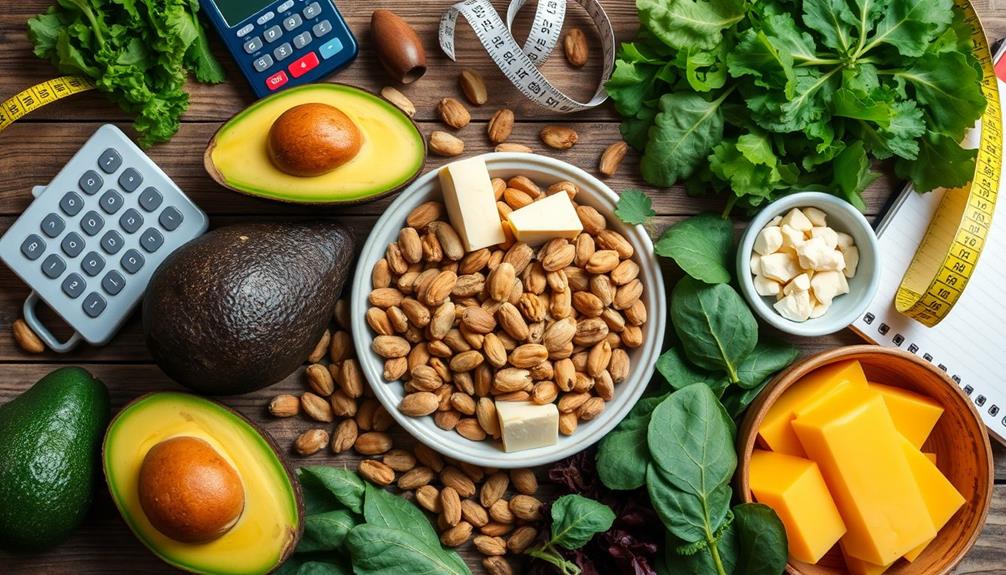The Keto diet works by drastically reducing your carbohydrate intake, pushing your body to burn fat for energy instead. By maintaining a high-fat, low-carb diet, you'll enter a state called ketosis, which can lead to significant weight loss—often around 2 pounds per week. However, you might also face challenges like the "keto flu," characterized by fatigue and headaches. While it can be effective in the short run, sustainability is a concern since strict carb limits can make long-term adherence tough. If you want to know more about managing this diet and its effects, keep exploring the details.
Key Takeaways
- The Keto diet promotes rapid weight loss by inducing ketosis, where the body uses fat for energy instead of carbohydrates.
- Ketosis enhances mental clarity and reduces hunger, aiding in appetite control and potentially leading to sustained weight loss.
- Initial weight loss on the Keto diet is often due to water loss; long-term results may vary and require careful management.
- The diet's restrictive nature can lead to nutrient deficiencies and challenges in long-term adherence, potentially resulting in weight regain.
- Gradual reintroduction of carbohydrates is crucial when transitioning off the Keto diet to minimize initial weight gain.
Overview of the Keto Diet

The ketogenic diet kicks off a metabolic shift by drastically reducing carbohydrate intake and increasing fat consumption. Generally, this low-carbohydrate, high-fat eating plan consists of 70-80% fat, 5-10% carbohydrates, and 10-20% protein. By enforcing strict carbohydrate restriction—often limited to 20-50 grams per day—you'll encourage your body to switch its primary energy source from glucose to ketone bodies, which are produced from fat during a state called ketosis.
This shift can enhance your overall health, similar to benefits observed from celery juice consumption, which is known for its detoxifying properties.
Originally developed for medical purposes, the keto diet has shown effectiveness in treating epilepsy, especially in children. Since the 1970s, it's gained popularity as a weight-loss strategy. By emphasizing healthy fats like avocados, nuts, and olive oil, the ketogenic diet encourages a more nutrient-dense approach to eating.
However, it prohibits grains, sugars, starchy vegetables, and most fruits, which can be a significant adjustment for many.
You might notice rapid initial weight loss on the keto diet, primarily due to water weight loss as your body depletes glycogen stores from carbohydrate intake. This metabolic shift can lead to sustained energy levels and improved focus for those who maintain the diet effectively.
How Ketosis Works

Achieving ketosis involves a notable metabolic shift where your body starts using ketone bodies for energy instead of glucose. This state occurs when you markedly reduce your carbohydrate intake, typically to below 50 grams per day.
After about 3-4 days of strict low-carb dieting, your liver begins converting stored fat into ketones, providing an alternative energy source. During this change, incorporating essential oils like clove oil may help alleviate any discomfort you experience as your body adjusts.
During ketosis, these ketone bodies can supply around 70% of your brain's energy needs, fueling mental clarity and focus. However, the change isn't always smooth. You might experience the "keto flu," which includes fatigue, headaches, and irritability as your body adapts to fat metabolism.
To maintain ketosis, you'll need to adhere to a diet high in healthy fats, making up about 70-80% of your daily caloric intake. This combination of low carbohydrate intake and increased healthy fats promotes efficient fat loss, as your body burns fat for energy instead of relying on glucose.
Dietary Guidelines and Foods

Steering through the keto diet requires a clear understanding of dietary guidelines and permissible foods. The ketogenic diet typically consists of 70-80% high fat, 5-10% low carb, and 10-20% protein. To achieve and maintain ketosis, you need to limit your carb intake to less than 50 grams per day.
It's vital to select the right foods to guarantee effective adherence to the diet, as certain foods can trigger cravings or lead to excess carb intake, potentially disrupting ketosis. Additionally, incorporating natural remedies can support overall health during dietary changes.
When meal planning, focus on foods to eat that align with these ratios. Incorporate high-fat items like fatty cuts of meat, olive and coconut oils, avocados, nuts, and low-carb vegetables such as leafy greens and cruciferous veggies.
On the flip side, there are significant foods to avoid. Stay clear of sugars found in sodas and cakes, grains like wheat and rice, most fruits (except small portions of berries), legumes, and starchy vegetables like potatoes and carrots.
Potential Risks and Concerns

Maneuvering the potential risks and concerns of the ketogenic diet is vital for anyone contemplating this eating plan. One major issue is its high saturated fat content, which can lead to increased LDL cholesterol levels and raise your risk of heart disease over time.
Additionally, the restrictive nature of the diet can result in nutrient deficiencies, as it limits many essential food groups needed for a balanced intake of vitamins and minerals. It's also important to take into account the emotional and psychological support available for individuals making significant lifestyle changes, such as through resources like Caregiver Support Network.
If you have pre-existing kidney conditions, be cautious; high protein intake may overload your kidney function. Many also experience "keto flu" during the initial adaptation phase, which can include fatigue, headaches, and digestive issues that might make sticking to the diet challenging.
For diabetic individuals, the risk of low blood sugar is significant, especially if you're on medication. This requires careful monitoring and medical guidance to guarantee safety.
Comparing Keto to Other Diets

When you compare the keto diet to other diets, you'll notice distinct differences in macronutrient ratios, especially with its high fat emphasis.
For instance, many diets promote balanced macronutrients, while keto focuses heavily on fats to induce ketosis.
You might find that while keto can enhance appetite control through increased satiety, its long-term sustainability often raises questions.
Understanding these factors can help you decide which dietary approach suits your lifestyle best, including considerations like savings goals for potential health-related expenses.
Macronutrient Ratios Comparison
The ketogenic diet stands out with its unique macronutrient ratios, typically comprising around 70-80% fat, 10-20% protein, and just 5-10% carbohydrates. This true keto diet focuses on high fat intake to induce ketosis, setting it apart from other low-carb diets.
It's important to note that effective strategies for weight loss often emphasize the role of macronutrient balance. Here's how the macronutrient ratios compare:
- Keto Diet: 70-80% fat, 10-20% protein, 5-10% carbohydrates.
- Atkins Diet: Starts higher in carbohydrates, often leading to a ratio of 40% fat, 30% protein, and 30% carbohydrates.
- Paleo Diet: Emphasizes whole foods with a balanced approach, typically around 40% fat, 30% protein, and 30% carbohydrates.
- South Beach Diet: Begins low-carb like keto, but shifts to approximately 30% fat, 30% protein, and 40% carbohydrates.
These differences in macronutrient ratios greatly affect how your body utilizes energy, influencing health benefits and body fat levels.
While ketogenic diets prioritize calories from fat, other diets allow for more varied carbohydrate and protein foods, offering diverse approaches to weight management.
Long-term Sustainability Issues
Many people struggle with the long-term sustainability of the keto diet due to its restrictive nature. While it may lead to initial weight loss, maintaining that success can be challenging.
Research shows that individuals often experience weight regain after discontinuing keto, as they revert to previous eating habits that contribute to weight gain. Unlike diets that promote gradual lifestyle changes, keto's strict carbohydrate limitations can create feelings of deprivation, making adherence difficult over time.
Individuals with emotional dysregulation, such as those with Borderline Personality Disorder, may find that restrictive diets exacerbate their symptoms and lead to impulsive eating behaviors, complicating their weight loss journey.
The average fat loss rate on keto is about 2 pounds per week, which might seem appealing, but it highlights that this rapid weight loss isn't necessarily sustainable. Many individuals find themselves battling increased cravings and appetite after stopping the diet.
This leads to challenges in maintaining long-term weight loss compared to more sustainable dietary patterns, like the Mediterranean diet, which emphasizes moderation and variety.
Incorporating a balanced approach that allows for more flexibility can promote adherence and help you develop a healthier relationship with food.
Ultimately, finding a diet that fits your lifestyle and supports gradual changes may be more effective for long-term success than the restrictive keto regimen.
Appetite Control Mechanisms
Appetite control plays an essential role in weight management, and the keto diet offers unique mechanisms that set it apart from other dietary approaches.
By stabilizing insulin levels, the ketogenic diet effectively reduces hunger signals, helping you manage cravings. This is particularly beneficial compared to high-carb diets, which often lead to insulin spikes and increased hunger.
Additionally, maintaining a healthy breast health routine, including regular screenings like mammography guidelines, can be significant for overall well-being.
Here are four key appetite control mechanisms of the keto diet:
- Insulin Stabilization: Lower insulin levels lead to reduced hunger signals, making it easier to stick to your plan.
- Ketone Bodies: Produced during ketosis, these provide an efficient energy source that curbs hunger and promotes satiety.
- High-Fat Foods: The emphasis on high-fat and protein-rich foods results in prolonged feelings of fullness, aiding in weight loss.
- Reduced Caloric Intake: Studies show that participants on the ketogenic diet experience lower hunger levels and a mean weight loss of 13% in just eight weeks.
Symptoms of Keto Flu

When you start the ketogenic diet, you might experience symptoms that mimic the flu, commonly known as keto flu.
These symptoms can last from a few days to a week and may include fatigue, headaches, and brain fog.
To alleviate discomfort during this shift, consider incorporating gentle stretching or meditation practices, which can help manage stress and promote relaxation yoga for back pain.
Understanding how to manage these effects can help you move more smoothly into ketosis.
Common Flu Symptoms
Starting a ketogenic diet can lead to a phenomenon often referred to as "keto flu." This term describes the set of symptoms you might experience as your body adjusts to a significant reduction in carbohydrates and shifts into ketosis.
During this changeover, you may notice several common symptoms that can make the initial phase challenging. Imagination mobilizes mental potential and can be a helpful tool in visualizing your goals and staying motivated throughout this process.
Here are four key symptoms to watch for:
- Tiredness and Lethargy: You might feel unusually fatigued as your body adapts to burning fats instead of carbs.
- Headaches: Mild headaches can occur as your body withdraws from sugar.
- Cognitive Effects: You may experience cloudy thinking or lightheadedness as your brain adjusts to a new energy source.
- Increased Hunger and Constipation: As your metabolism shifts, you could feel hungrier and experience digestive changes.
These symptoms are usually temporary and typically resolve as your body becomes more efficient at utilizing ketone bodies for energy.
Staying well-hydrated and ensuring adequate electrolyte intake can help alleviate some of the discomfort associated with keto flu symptoms.
Duration of Symptoms
As you navigate the early stages of the ketogenic diet, it's important to understand how long the symptoms of keto flu might last. These temporary symptoms usually occur during the initial shift to ketosis and can last anywhere from a few days to a week. Most people hit a peak in symptoms around the second or third day, as their bodies adjust to lower carbohydrate intake.
| Symptom | Duration | Intensity |
|---|---|---|
| Fatigue | 2-7 days | Moderate to High |
| Headaches | 1-5 days | Mild to Severe |
| Dizziness | 1-3 days | Mild to Moderate |
| Irritability | 1-5 days | Variable |
While these symptoms can be uncomfortable, they're usually temporary and will subside as your body adapts to fat metabolism and enters a stable state of ketosis. Staying well-hydrated and ensuring adequate electrolyte intake can help ease this adjustment period, making the shift smoother. Remember, the discomfort is just a sign that your body is changing and adapting to a new way of fueling itself.
Management Strategies
Managing the challenges of keto flu can feel overwhelming, but effective management strategies can ease your change into ketosis. To minimize symptoms as your body adjusts to fat metabolism, consider the following:
1. Stay Hydrated: Drinking plenty of water helps combat dehydration, which is common during the change.
Additionally, incorporating essential oils like peppermint can provide a revitalizing sensation and support overall wellness during this time, especially when used in a diffuser for a calming atmosphere aromatherapy techniques for relaxation.
2. Ensure Adequate Electrolyte Intake: Include foods rich in sodium, potassium, and magnesium to alleviate symptoms like headaches and fatigue.
3. Gradually Reduce Carbohydrates: Instead of cutting carbs drastically, taper them down over several days to lessen the severity of keto flu symptoms.
4. Engage in Light Physical Activity: Gentle exercises such as walking or stretching can boost your mood and energy levels while your body adapts.
Transitioning Off Keto Diet

Shifting off the keto diet requires a thoughtful approach to reintroducing carbohydrates into your meals. Start by gradually adding around 100-135 grams of carbohydrates daily to avoid rapid weight gain and digestive issues. Focus on whole, unrefined sources like whole grains, fruits, and vegetables. This guarantees a balanced nutrient intake during your shift.
As you increase your carbohydrate intake, expect some initial weight gain. This is primarily due to water retention as your glycogen stores refill. It's vital to remember that this temporary increase doesn't necessarily reflect fat gain.
To navigate this shift smoothly, consider consulting a healthcare professional or dietitian. They can help you create a sustainable eating plan tailored to your needs.
Developing a long-term strategy for healthy eating after keto is important for maintaining weight loss and overall health. Incorporate a variety of foods while monitoring your body's response, adjusting as necessary.
Frequently Asked Questions
Does the Keto Diet Really Work for Weight Loss?
When you follow the keto diet, you'll reduce carbs and often experience quick weight loss. However, while it may help initially, sustainable results depend on your long-term commitment and lifestyle changes.
Is There a Downside to the Keto Diet?
Imagine a bright, enticing cake, but beneath its frosting lies a hidden sourness. You'll face potential nutrient deficiencies, "keto flu," and risks to heart health. It's crucial to weigh these downsides before diving in.
How Much Weight Can You Lose in a Month on Keto?
You can lose around 4 to 10 pounds in the first month on keto, primarily from water weight and fat loss. After that, expect a steady rate of about 1 to 2 pounds per week.
Will Keto Diet Reduce Belly Fat?
Imagine your body transforming into a fat-burning machine. Yes, the keto diet can help reduce belly fat. By slashing carbs and embracing healthy fats, you're likely to witness that stubborn fat melting away over time.
Conclusion
So, does the keto diet really work? Well, if you enjoy counting carbs like a mathematician on a caffeine high, then it just might be your thing! You'll trade bread for butter and revel in bacon bliss, all while dodging the dreaded keto flu. Just remember, shifting off might feel like saying goodbye to a long-lost friend—except that friend is bread. Embrace the irony: in a world full of choices, you might just find joy in cutting carbs!









